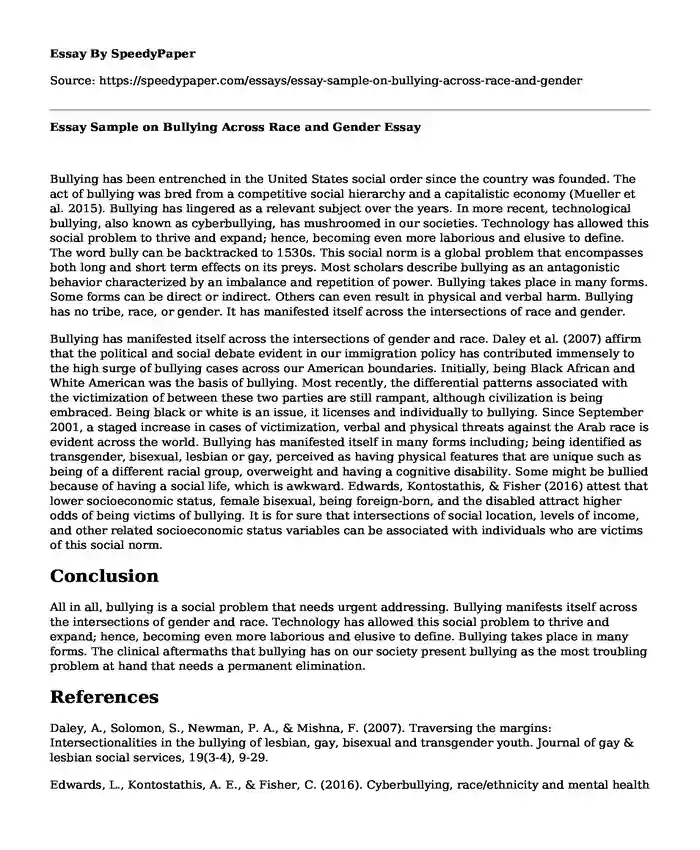Bullying has been entrenched in the United States social order since the country was founded. The act of bullying was bred from a competitive social hierarchy and a capitalistic economy (Mueller et al. 2015). Bullying has lingered as a relevant subject over the years. In more recent, technological bullying, also known as cyberbullying, has mushroomed in our societies. Technology has allowed this social problem to thrive and expand; hence, becoming even more laborious and elusive to define. The word bully can be backtracked to 1530s. This social norm is a global problem that encompasses both long and short term effects on its preys. Most scholars describe bullying as an antagonistic behavior characterized by an imbalance and repetition of power. Bullying takes place in many forms. Some forms can be direct or indirect. Others can even result in physical and verbal harm. Bullying has no tribe, race, or gender. It has manifested itself across the intersections of race and gender.
Bullying has manifested itself across the intersections of gender and race. Daley et al. (2007) affirm that the political and social debate evident in our immigration policy has contributed immensely to the high surge of bullying cases across our American boundaries. Initially, being Black African and White American was the basis of bullying. Most recently, the differential patterns associated with the victimization of between these two parties are still rampant, although civilization is being embraced. Being black or white is an issue, it licenses and individually to bullying. Since September 2001, a staged increase in cases of victimization, verbal and physical threats against the Arab race is evident across the world. Bullying has manifested itself in many forms including; being identified as transgender, bisexual, lesbian or gay, perceived as having physical features that are unique such as being of a different racial group, overweight and having a cognitive disability. Some might be bullied because of having a social life, which is awkward. Edwards, Kontostathis, & Fisher (2016) attest that lower socioeconomic status, female bisexual, being foreign-born, and the disabled attract higher odds of being victims of bullying. It is for sure that intersections of social location, levels of income, and other related socioeconomic status variables can be associated with individuals who are victims of this social norm.
Conclusion
All in all, bullying is a social problem that needs urgent addressing. Bullying manifests itself across the intersections of gender and race. Technology has allowed this social problem to thrive and expand; hence, becoming even more laborious and elusive to define. Bullying takes place in many forms. The clinical aftermaths that bullying has on our society present bullying as the most troubling problem at hand that needs a permanent elimination.
References
Daley, A., Solomon, S., Newman, P. A., & Mishna, F. (2007). Traversing the margins: Intersectionalities in the bullying of lesbian, gay, bisexual and transgender youth. Journal of gay & lesbian social services, 19(3-4), 9-29.
Edwards, L., Kontostathis, A. E., & Fisher, C. (2016). Cyberbullying, race/ethnicity and mental health outcomes: A review of the literature. Media and Communication, 4(3), 71-78.
Mueller, A. S., James, W., Abrutyn, S., & Levin, M. L. (2015). Suicide ideation and bullying among US adolescents: Examining the intersections of sexual orientation, gender, and race/ethnicity. American journal of public health, 105(5), 980-985.
Cite this page
Essay Sample on Bullying Across Race and Gender. (2023, Jan 31). Retrieved from https://speedypaper.com/essays/essay-sample-on-bullying-across-race-and-gender
Request Removal
If you are the original author of this essay and no longer wish to have it published on the SpeedyPaper website, please click below to request its removal:
- Free Essay on Academic Writing: Academic and Non-Academic Tone
- Free Essay on Teck Talk - The Return of Polaroids
- Free Essay with Employee Empowerment Article Review
- Nursing Essay Example on Advanced Nurse Practice
- Industrial Hygiene Essay Example
- Observation in a Night Club
- Free Essay Example - Principles of Management
Popular categories





